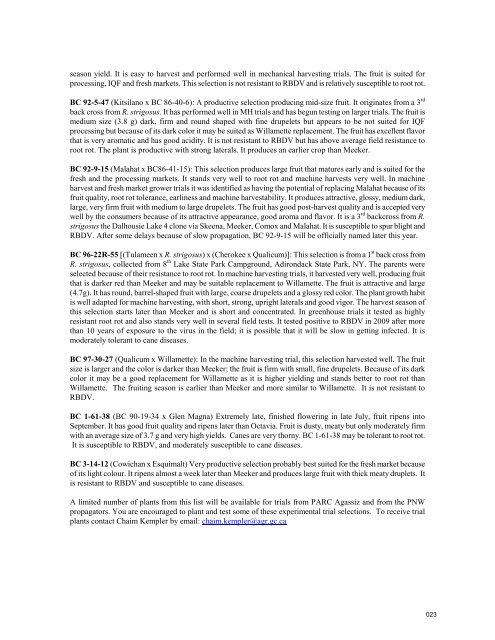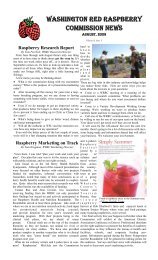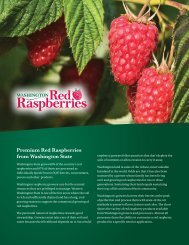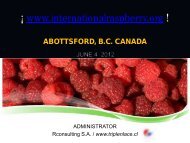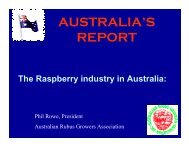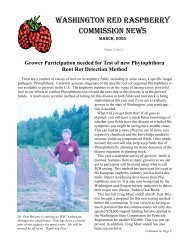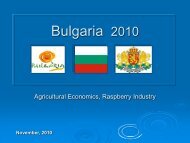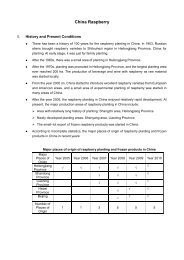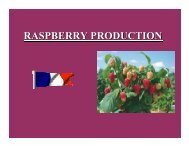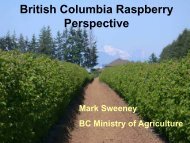2012 - Washington Red Raspberry Commission
2012 - Washington Red Raspberry Commission
2012 - Washington Red Raspberry Commission
Create successful ePaper yourself
Turn your PDF publications into a flip-book with our unique Google optimized e-Paper software.
season yield. It is easy to harvest and performed well in mechanical harvesting trials. The fruit is suited for<br />
processing, IQF and fresh markets. This selection is not resistant to RBDV and is relatively susceptible to root rot.<br />
BC 92-5-47 (Kitsilano x BC 86-40-6): A productive selection producing mid-size fruit. It originates from a 3 rd<br />
back cross from R. strigosus. It has performed well in MH trials and has begun testing on larger trials. The fruit is<br />
medium size (3.8 g) dark, firm and round shaped with fine drupelets but appears to be not suited for IQF<br />
processing but because of its dark color it may be suited as Willamette replacement. The fruit has excellent flavor<br />
that is very aromatic and has good acidity. It is not resistant to RBDV but has above average field resistance to<br />
root rot. The plant is productive with strong laterals. It produces an earlier crop than Meeker.<br />
BC 92-9-15 (Malahat x BC86-41-15): This selection produces large fruit that matures early and is suited for the<br />
fresh and the processing markets. It stands very well to root rot and machine harvests very well. In machine<br />
harvest and fresh market grower trials it was identified as having the potential of replacing Malahat because of its<br />
fruit quality, root rot tolerance, earliness and machine harvestability. It produces attractive, glossy, medium dark,<br />
large, very firm fruit with medium to large drupelets. The fruit has good post-harvest quality and is accepted very<br />
well by the consumers because of its attractive appearance, good aroma and flavor. It is a 3 rd backcross from R.<br />
strigosus the Dalhousie Lake 4 clone via Skeena, Meeker, Comox and Malahat. It is susceptible to spur blight and<br />
RBDV. After some delays because of slow propagation, BC 92-9-15 will be officially named later this year.<br />
BC 96-22R-55 [(Tulameen x R. strigosus) x (Cherokee x Qualicum)]: This selection is from a 1 st back cross from<br />
R. strigosus, collected from 8 th Lake State Park Campground, Adirondack State Park, NY. The parents were<br />
selected because of their resistance to root rot. In machine harvesting trials, it harvested very well, producing fruit<br />
that is darker red than Meeker and may be suitable replacement to Willamette. The fruit is attractive and large<br />
(4.7g). It has round, barrel-shaped fruit with large, coarse drupelets and a glossy red color. The plant growth habit<br />
is well adapted for machine harvesting, with short, strong, upright laterals and good vigor. The harvest season of<br />
this selection starts later than Meeker and is short and concentrated. In greenhouse trials it tested as highly<br />
resistant root rot and also stands very well in several field tests. It tested positive to RBDV in 2009 after more<br />
than 10 years of exposure to the virus in the field; it is possible that it will be slow in getting infected. It is<br />
moderately tolerant to cane diseases.<br />
BC 97-30-27 (Qualicum x Willamette): In the machine harvesting trial, this selection harvested well. The fruit<br />
size is larger and the color is darker than Meeker; the fruit is firm with small, fine drupelets. Because of its dark<br />
color it may be a good replacement for Willamette as it is higher yielding and stands better to root rot than<br />
Willamette. The fruiting season is earlier than Meeker and more similar to Willamette. It is not resistant to<br />
RBDV.<br />
BC 1-61-38 (BC 90-19-34 x Glen Magna) Extremely late, finished flowering in late July, fruit ripens into<br />
September. It has good fruit quality and ripens later than Octavia. Fruit is dusty, meaty but only moderately firm<br />
with an average size of 3.7 g and very high yields. Canes are very thorny. BC 1-61-38 may be tolerant to root rot.<br />
It is susceptible to RBDV, and moderately susceptible to cane diseases.<br />
BC 3-14-12 (Cowichan x Esquimalt) Very productive selection probably best suited for the fresh market because<br />
of its light colour. It ripens almost a week later than Meeker and produces large fruit with thick meaty druplets. It<br />
is resistant to RBDV and susceptible to cane diseases.<br />
A limited number of plants from this list will be available for trials from PARC Agassiz and from the PNW<br />
propagators. You are encouraged to plant and test some of these experimental trial selections. To receive trial<br />
plants contact Chaim Kempler by email: chaim.kempler@agr.gc.ca<br />
023


